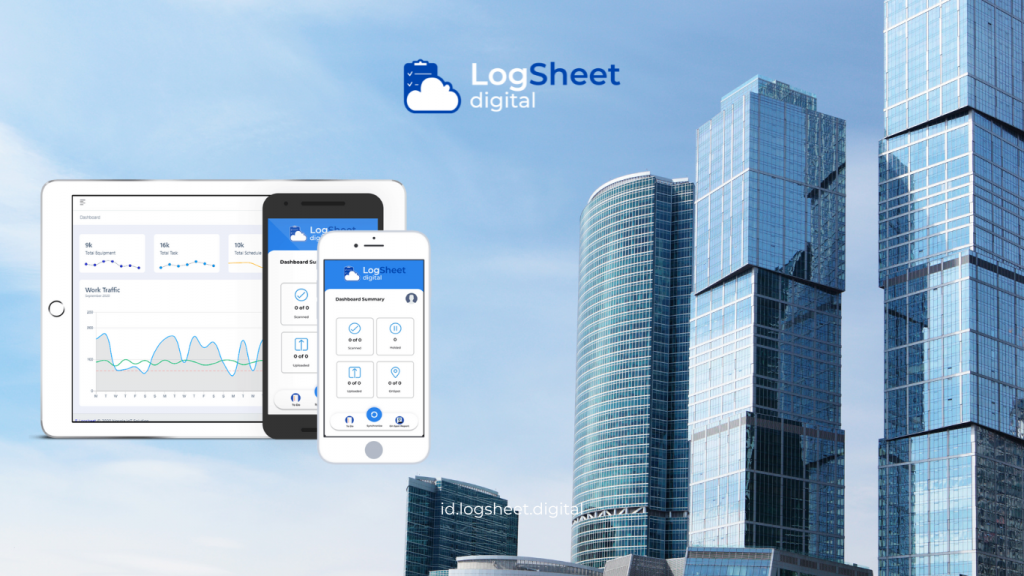In the era of Industry 4.0, data has become a core element in business strategies. Many companies are now switching to digital systems to simplify the recording and monitoring of daily activities. One significant innovation is the implementation of digital logsheet, which replace manual recording methods and allow for deeper data analysis. With digital logsheets, companies can collect, store, and manage data more effectively, supporting quick, accurate, and data-driven decision-making.
This article will delve deeper into digital logsheet, covering their definition, advantages, and benefits in supporting data analysis and decision-making. Additionally, we will outline the challenges of implementation, tips for successful adoption, and examples of usage across various industrial sectors.
What Is a Digital Logsheets?

Read More: Digital Logsheets and Safety Awareness: A Case Study in Industry
A digital logsheets is an application or system designed for automatic data recording, replacing manual paper-based recording methods. With digital logsheets, data recording can be done instantly and accessed by various departments in real-time. Unlike manual methods that take longer and are prone to human error, digital logsheets allow companies to obtain more accurate and consistent data.
Comparison of Digital Logsheets and Manual Logsheets
| Criteria | Manual Logsheets | Digital Logsheets |
|---|---|---|
| Time Efficiency | Time-consuming to record | Automatic and quick recording |
| Accuracy | Prone to human error | High accuracy level |
| Accessibility | Limited and slow | Real-time and multi-user access |
| Data Security | Risk of loss or damage | Data protected and can be backed up |
| Data Analysis | Not effective for in-depth analysis | Enables automated data analysis |
Why Are Digital Logsheets Important for Data Analysis?

Read More: Data Security in Digital Logsheets: Challenges and Security Strategies in Calibration
Digital logsheets are not just tools for recording information but also platforms that provide deeper operational insights through data. Here are several reasons why digital logsheets are crucial for data analysis:
- Real-Time Data Availability
With digital logsheets, data can be accessed instantly without waiting for manual reports. This allows for faster analysis and immediate decision-making based on current information. - Integration with Other Systems
Digital logsheets can be integrated with other devices and software such as Enterprise Resource Planning (ERP) or the Internet of Things (IoT). This integration allows data from various sources to be analyzed together, resulting in more comprehensive insights. - Automated Analysis Capability
Data collected digitally can be processed using algorithms or analytical tools. For example, digital logsheets enable companies to utilize predictive analytics to forecast operational needs or potential failures in the future.
Benefits of Digital Logsheets for Decision-Making

Read More: Digital Logsheets in Improving Safety and Reducing Risks in the Workplace
Digital logsheets support companies in data-driven decision-making by providing accurate, real-time, and easily accessible data. Here are some key benefits of digital logsheets in the decision-making process:
1. Improving Operational Efficiency
Data recorded through digital logsheets allows companies to identify areas needing improvement. Thus, efficiency measures can be implemented immediately, such as adjusting operational schedules or optimizing resource utilization.
2. Reducing Operational Costs
The use of digital logsheets helps companies identify waste, such as excessive energy use or inefficient material consumption. With proper data analysis, companies can implement significant cost savings.
3. Facilitating Faster Decision-Making
Real-time data availability makes it easier for management to make quick decisions based on current operational conditions. This is crucial in situations requiring rapid response, such as addressing technical issues or adjusting production strategies.
4. Enhancing Customer Satisfaction
By analyzing data from digital logsheets, companies can improve the quality of their products and services. Better decision-making regarding equipment maintenance or production quality monitoring can prevent errors, ensure product quality, and enhance customer satisfaction.
Examples of Digital Logsheets Implementation Across Various Sectors

Read More: Enhancing Security and Quality of Delivery: Digital Logsheets in Logistics
Digital logsheets can be applied across various industrial sectors with varying benefits. Here are some examples of digital logsheets implementation in key sectors:
1. Manufacturing Sector
In the manufacturing industry, digital logsheets are often used to monitor machine and production equipment conditions. With real-time performance data, maintenance teams can plan more effective preventive maintenance, thus reducing costly downtimes.
2. Energy and Utilities Sector
In the energy sector, digital logsheets are used to monitor energy consumption and support sustainability policies. Collected energy usage data can be analyzed to optimize consumption efficiency and reduce carbon footprints.
3. Healthcare Sector
Hospitals and healthcare facilities use digital logsheets to record medical equipment data and patient information. Recorded data helps in making faster decisions in critical situations and enhances patient safety.
4. Transportation and Logistics Sector
In this sector, digital logsheets serve to manage operational vehicle schedules and monitor equipment conditions. With accurate data, companies can enhance transportation efficiency, reduce fuel costs, and improve delivery timeliness.
Challenges in Implementing Digital Logsheets

Read More: Overcoming Implementation Challenges of Digital Logsheets on Safety Equipment
Implementing digital logsheets offers many benefits but also presents several challenges, including:
1. Implementation Costs
The initial investment in a digital logsheets system can be quite high, especially for software and staff training. Small companies may find this cost burdensome.
2. Employee Adaptation and Cultural Change
The shift from manual logsheets to digital ones requires adaptation from all employees. In addition, companies need to invest time and effort in training to ensure a smooth transition. Moreover, this training should be comprehensive, covering not only how to use the new system but also its benefits. Furthermore, involving employees in the process can foster a sense of ownership and reduce resistance to change. Ultimately, a well-prepared workforce will facilitate a more efficient and successful implementation of digital logsheets.
3. Data Security
Digital logsheets collect sensitive data that must be well-protected. Consequently, the risk of data breaches or cyberattacks is a significant concern. Therefore, it is essential to address these risks with adequate security measures. Moreover, implementing strong security protocols not only protects sensitive information but also builds trust with stakeholders. As a result, companies should prioritize security in their digital logsheet systems to mitigate potential threats effectively.
4. System Maintenance
Routine maintenance to keep digital logsheets performing optimally is crucial. In addition, without adequate maintenance, systems can experience downtime or lose valuable data. Therefore, regular checks and updates are necessary to ensure the reliability and effectiveness of these systems. Ultimately, consistent maintenance helps safeguard against potential issues and enhances overall performance.
Tips for Successful Implementation of Digital Logsheets

To ensure the successful implementation of digital logsheets and maximize benefits, here are some tips to consider:
- Choose a System That Meets Your Needs
Every industry has different requirements. Ensure that the selected system can meet the specific needs of the company and adapt to future business changes. - Provide Training for Employees
The transition to digital logsheets should be supported by adequate training. Ensure employees understand how the new system works and its benefits for their work. - Ensure Data Security
Data security is a crucial aspect of digital logsheets. Ensure that the system is equipped with strong protections to prevent security threats. - Evaluate and Improve the System Regularly
Conduct periodic evaluations of the digital logsheets’ performance. This way, companies can identify areas that need improvement or system modifications.
Conclusion

Read More: Digital Logsheets for Better Asset Management Sustainability
Digital logsheets are a modern solution that enables companies to obtain more accurate data, conduct in-depth analyses, and make better decisions. By leveraging this technology, companies can enhance operational efficiency, reduce costs, and improve the quality of products and services. While there are challenges in implementation, such as initial costs and cultural changes, the benefits gained far outweigh these challenges for long-term business growth.
Digital logsheets are a crucial component of the digital transformation that provides a competitive advantage in an increasingly data-focused era. Moreover, with proper planning, appropriate training, and robust security systems in place, companies can fully utilize digital logsheets to support data-driven decision-making. As a result, they can enhance their operational efficiency and make more informed decisions.






comments (0)